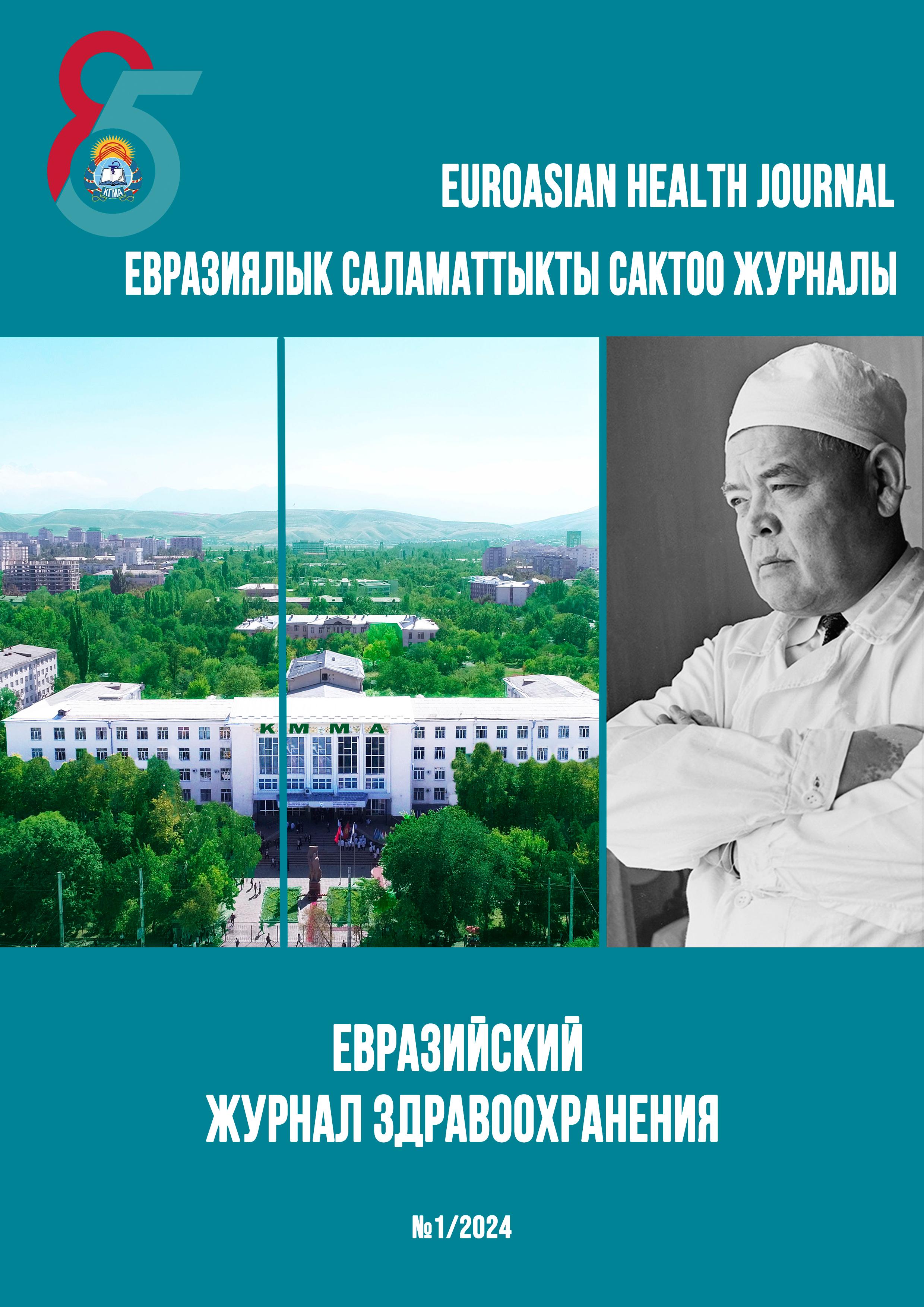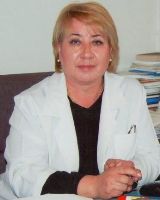ОЦЕНКА ОБЕСПЕЧЕННОСТИ ВИТАМИНОМ D НАСЕЛЕНИЯ КЫРГЫЗСКОЙ РЕСПУБЛИКИ
DOI:
https://doi.org/10.54890/EHJ-2024-1-80Аннотация
Актуальность. Известна важная роль витамина D в процессах функционирования иммунной, сердечно-сосудистой систем организма, а также в различных физиологических процессах, в том числе клеточном росте, нервно- мышечной проводимости. Недостаток его в организме вызывает риск развития инфекционных, сердечно-сосудистых, онкологических и др. заболеваний. В связи с этим, дефицит витамина D представляет актуальную проблему общественного здравоохранения в мире, в том числе, и в КР. Цель: исследовать уровень обеспеченности витамином D у различных групп населения КР по сезонам года. Материалы и методы. Проведен анализ исследований содержания витамина D лабораторией «Гемотест» у 6274 человек из различных областей КР с января 2019г по август 2023г. Для лабораторных исследований применяется метод электрохемилюминесцентный иммунотест (ECLIA). Результаты. Приведены результаты содержания (уровня) витамина D по полу, по годам, по регионам КР. Выводы. Анализ проведенного исследования показал, что в целом по КР только 35,48% обследованных имели адекватный уровень обеспеченности витамина D. Самая высокая доля населения с недостаточностью витамина D отмечена в южном регионе КР (Баткенская, Жалалабадская и Ошская области), в основном больше у женщин и подростков.
Ключевые слова:
Витамин D, общественное здравоохранение, оценка, дефицит, недостаточность, возрастные группы, времена года, Кыргызская Республика.Библиографические ссылки
1. Мальцев С.В. Современные данные о витамине D - метаболизм, роль в организме, особенности применения в практике врача. Практическая медицина. 2020;18(4):8–22. [Maltsev S.V. Modern data on vitamin D - metabolism, role in the body, features of use in the practice of a doctor. Practical medicine. 2020;18(4):8–22 (in Russ.)]. https://doi.org/10.32000/2072-1757-2020-4-8-22
2. Zhang L, Zhang S, He C, Wang X. VDR Gene Polymorphisms and Allergic Diseases: Evidence from a Meta-analysis. Immunol Invest. 2020;49(1–2):166–177. https://doi.org/10.1080/08820139.2019.1674325
3. Pludowski P, Holick MF, Pilz S, Wagner CL, Hollis BW, Grant WB, et al. Vitamin D effects on musculoskeletal health, immunity, autoimmunity, cardiovascular disease, cancer, fertility, pregnancy, dementia and mortality review of recent evidence. Autoimmun Rev. 2013;12(10):976-989. https://doi.org/10.1016/j.autrev.2013.02.004
4. Bartley J. Vitamin D, innate immunity and upper respiratory tract infection. J Laryngol Otol. 2010;124(5):465–469. https://doi.org/10.1017/s0022215109992684
5. Zittermann A, Schleithoff SS, Koerfer R. Putting cardiovascular disease and vitamin D insufficiency into perspective. Br J Nutr. 2007; 94(04):483. https://doi.org/10.1079/bjn20051544
6. Ahmed AE, Sakhr HM, Hassan MH, El-Amir MI, Ameen HH. Vitamin D Receptor rs7975232, rs731236 and rs1544410 Single Nucleotide Polymorphisms, and 25-Hydroxyvitamin D Levels in Egyptian Children with Type 1 Diabetes Mellitus: Effect of Vitamin D Co-Therapy. Diabetes Metab Syndr Obes. 2019;12:703–716. https://doi.org/10.2147/DMSO.S201525
7. Sentinelli F, Bertoccini L, Barchetta I, Capoccia D, Incani M, Pani MG, et al. The Vitamin D Receptor (VDR) Gene rs11568820 Variant Is Associated with Type 2 Diabetes and Impaired Insulin Secretion in Italian Adult Subjects, and Associates with Increased Cardio-Metabolic Risk in Children. Nutr Metab Cardiovasc Dis. 2016;26(5):407–413. https://doi.org /10.1016/j.numecd.2016.02.004
8. Shi X.Y., Huang A.P., Xie D.W., Yu X.L. Association of Vitamin D Receptor Gene Variants with Polycystic Ovary Syndrome: A Meta-Analysis. BMC Med Genet. 2019;20(1):32. https://doi.org/10.1186/s12881-019-0763-5
9. Charoenngam N, Shirvani A, Kalajian TA, Song A, Holick MF. The Effect of Various Doses of Oral Vitamin D3 Supplementation on Gut Microbiota in Healthy Adults: A Randomized, Double-blinded, Dose-response Study. Anticancer Res. 2020;40(1):551–556. https://doi.org/10.21873/anticanres.13984
10. Zhang L, Wang S, Che X, Li X. Vitamin D and lung cancer risk: A comprehensive review and meta-analysis. Cell Physiol Biochem 2015; 36 (1):299–305. https://doi.org/10.1159/000374072
11. Группа экспертов высокого уровня. Питание и продовольственные системы. Доклад Группы высокого уровня по продовольственной безопасности и питанию Комитета по всемирной продовольственной безопасности. Рим; 2017. 189 с. Режим доступа: https://www.fao.org/3/I7846RU/i7846ru.pdf
12. Каронова Т.Л., Гринева Е.Н., Никитина И.Л., Цветкова Е.В., Тодиева А.М., Беляева О.Д., и др. Распространенность дефицита витамина D в Северо-Западном регионе РФ среди жителей Санкт-Петербурга и Петрозаводска. Остеопороз и остеопатии. 2013;16(3):3-7. [Karonova T.L., Grinyova E.N., NikitiM I.L., Tsvetkova E.V., Todieva A.M., Belyaeva O.D., Mikheeva E.P., Globa P.Yu., Andreeva A.T., Beletskaya I.S., Omelchuk N.V., Fulonova L.S., Shlyakhto E.V. The prevalence of vitamin D deficiency in the Northwestern region of the Russian Federation among the residents of St. Petersburg and Petrozavodsk. Osteoporosis and Bone Diseases. 2013;16(3):3-7. (In Russ.)]. https://doi.org/10.14341/osteo201333-7
13. Isupova AA, Isupov RV. Determinants of serum 25(OH)D indicators of Kyrgyzstan. Health care of Kyrgyzstan. 2021;4:34-39. https://doi.org/10.51350/zdravkg 2021124334
14. Kondratyeva EI, Loshkova EV, Zakharova IN, Shubina YF, Saprina TV, Nikonova VS, et al. Assessment of vitamin D supply at different age. Meditsinskiy sovet = Medical Council. 2021;(12):294-303. (In Russ.) https://doi.org/10.21518/2079-701X-2021-12-294-303







